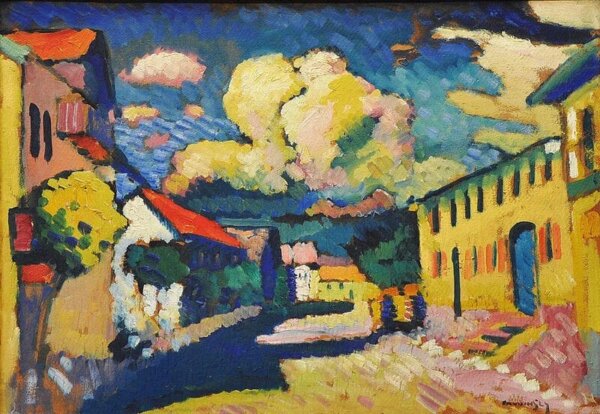Art is wonderful. Indeed, each artwork conveys its own distinct kind of magic, and it really doesn’t matter whether you understand it or not. There’s been a number of important art movements over the years. Some of them, thanks to their beauty, have stood the test of time. One such movement is expressionism. This particular movement has left behind a strong and lasting impression. Its works appear simple. However, they have depth and beauty. Furthermore, there’s something rather curious about expressionist art and its close links with intuition.
The way in which expressionist artists distorted reality is one of the reasons why this movement remains unparalleled.
In this article, you’ll learn about expressionism, a world full of color and emotion. You’ll discover its origins, its characteristics, and some expressionist artists.
“Painting is a state of being. Every good artist paints what he is.”
-Jackson Pollack-
What’s expressionist art?
Expressionism is an avant-garde artistic and cultural movement. It originated in Berlin in the 20th century. As well as art, it encompassed music, dance, theatre, film, and literature. However, although it began in Berlin, expressionist art wasn’t just located there. In fact, there’s also Nordic, French, and Spanish expressionism, amongst others. In addition, the fact that it comes from so many places makes it even more interesting.
It’s important to remember that this art form manifests itself in a huge variety of styles. That’s because each individual artist worked from their own perspective. For this reason, expressionist art encompasses everything, from overly colorful trends to the more abstract forms of expressionism.
To talk about expressionism is to talk about an art of renewal, intuition, and emotion. In fact, there’s tremendous subjectivity in these works. Indeed, unlike impressionists, expressionists focus relatively little on reality.
The characteristics of expressionist art
As with every artistic movement, expressionism has certain characteristics. However, because there’s such a variety in the different works of this particular movement, they can be quite difficult to recognize. Here are some of its main characteristics:
- Distortion of reality. Expressionists didn’t capture reality. In fact, they expressed what was going on inside them. This gave a more subjective and individual perspective to their work.
- Interior vision. They didn’t imitate everyday life. They focused on what came from within. Therefore, it’s an intuitive art.
- Expression. They highlighted emotions and thoughts. In effect, they reflected on the nature of being human.
- Dramatic charge. They represented man’s anxieties. Furthermore, they addressed creation from a critical standpoint in an intense and slightly pessimistic manner.
The most important quality in this movement is that of freedom of expression, focused on emotions. Consequently, the artists show the viewers their feelings in an extremely intense way. In fact, these artists are actually trying to find themselves deep within the depths of their souls. They then embody those inner depths within their beautiful works of art.
Due to the political climate at this point in history, these were particularly tense times. For this reason, there was a feeling of real unrest in the population. Therefore, expressionists tend to exhibit a sense of both fragmentation and frustration in their works.
Famous expressionist artists
There are several expressionist painters. Here are a few:
- Otto Mueller. He was a Polish painter. He joined the expressionist group Die Brücke. Famous for his nude paintings. In fact, the Nazis regarded them as degenerate art and confiscated them.
- Wassily Kandinsky. Famous for his abstract art. His paintings are simple and richly colorful.
- Jackson Pollack. Characterized by his highly original style. In addition, by his action paintings. These were carried out by him spontaneously spilling paint onto the canvas.
- Paul Klee. He was a German painter. He also used a lot of colors. His works are full of movement, rhythm, nature, and color.
- Egon Schiele. He was a radical expressionist and ravaged social conventions with his depiction of the human figure. He also aggressively distorted the figures of nudes in his paintings.

Franz Kafka was one of the most prominent figures in expressionist literature. He was a Czech writer who demonstrated the anxieties and uncertainties of being human in his works. Another author was Thomas Mann. His works were laden with intent. In fact, he delved into a spectacular and pessimistic world. His most important work was The Magic Mountain.
Robert Wiene excelled in the film industry. He was a silent film director. In his film The Cabinet of Dr. Caligari, he reflected on the political environment. Another prominent figure was Bruno Taut. He was an architect who used colors as a psychological element.
In the field of expressionist sculpture, Ernst Barlach and Jacob Epstein deserve a mention. Barlach’s known for his bronze and wood sculptures. Most of his works had anti-war sentiments, so were also classified as degenerate art by the Nazis.
Epstein was known for the controversy caused by his works such as The Tomb of Oscar Wilde, which was regarded as obscene.
Where can you view expressionist art?
Here are some places you can view expressionist art in all its glory. Furthermore, some of these museums have online galleries. Therefore, if you can’t actually get to the galleries, you can still easily view the paintings.
- Brücke Museum. One of the most important expressionist museums. It’s located in Berlin. Furthermore, it contains the largest collection of expressionist art.
- Jorge Rando Museum. This is the first expressionist art museum in Spain. It’s located in Malaga. It has a room dedicated to the neo-expressionist author Jorge Rando.
- Galleries and museums of abstract expressionism. There’s a website called The Art Story. It contains a list of places where you can see this type of art.
- Guggenheim Museum. This museum is in New York. It contains wonderful expressionist works by artists like Max Ernst, Wassily Kandinsky, and Paul Klee. In addition, it has an unrivaled online collection.
Expressionism is a movement full of emotion. Furthermore, it shows you in an extremely profound way what it means to be human. In fact, this movement is so diverse that you have to marvel at its many nuances. Each artist and author are completely different, and each of them invites you to reflect on their own individual messages. Finally, there’s absolutely no doubt that expressionism was a forceful movement that sought to bring a degree of authenticity to the world of art.
The post Expressionist Art: A Distortion of Reality appeared first on Exploring your mind.



















Comments